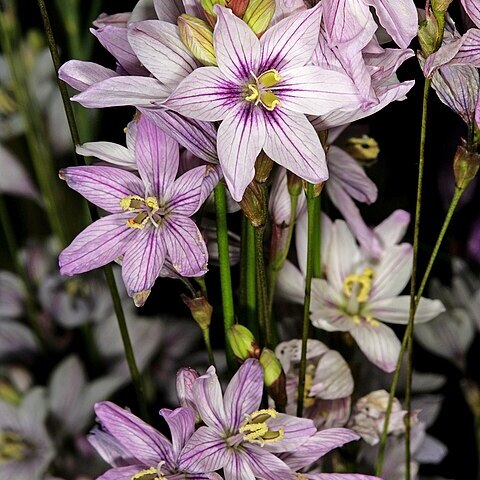Perennial herb, geophyte, 0.3-0.6 m high; corm ovoid or subglobose, tunics of fine fibres, confluent and reticulate above; stem wiry, often simple. Leaves 3-5, linear to ensiform, usually spirally twisted, 50-350 x 2-5 mm, (sub)erect, midrib slightly prominent. Bracts ovate, shortly tricuspidate or tridentate, pellucid, usually pinkish with dark veins. Inflorescence a short, compact, subcapitate spike, 4-12-flowered; rachis ± flexuose; flowers pink, mauve or white with darker streaks; perianth tube filiform, 4-6 mm long; tepals spreading, oblong, obtuse, connate, subequal. Stamens exserted, tapering above; anthers linear-oblong. Ovary rotund; style usually reaching middle of filaments; branches oblanceolate or linear and slightly expanded towards apex, conduplicate. Flowering time Aug., Sept.
Herb 30-55 cm tall. Corm 1-1.3 cm diam. Leaves 3-5, erect, linear, 10-30 cm long, 2-6 mm wide, about 5-veined with prominent midvein, often spirally twisted. Stem unbranched or with 1-4 spreading branches. Spike dense, 3-15-flowered, slightly flexuose. Bracts ovate, 5-7 mm long, translucent, tinged pink, often with pink veins. Flowers white or pale mauve to pink, often with yellowish centre. Perianth tube filiform, 4-6 mm long; lobes slightly campanulate at base, spreading, obtuse, 1-1.5 cm long, 5-8 mm wide. Filaments 3.5-4.5 mm long; anthers 3-4.5 mm long. Ovary c. 3 mm long; style branches spreading at or below the level of anthers, 2-4 mm long.
Cormous geophyte, 35-65 cm, stems wiry, often unbranched. Leaves linear. Flowers in congested spikes, pink, mauve or white, honey-suckle-scented, tube filiform.

